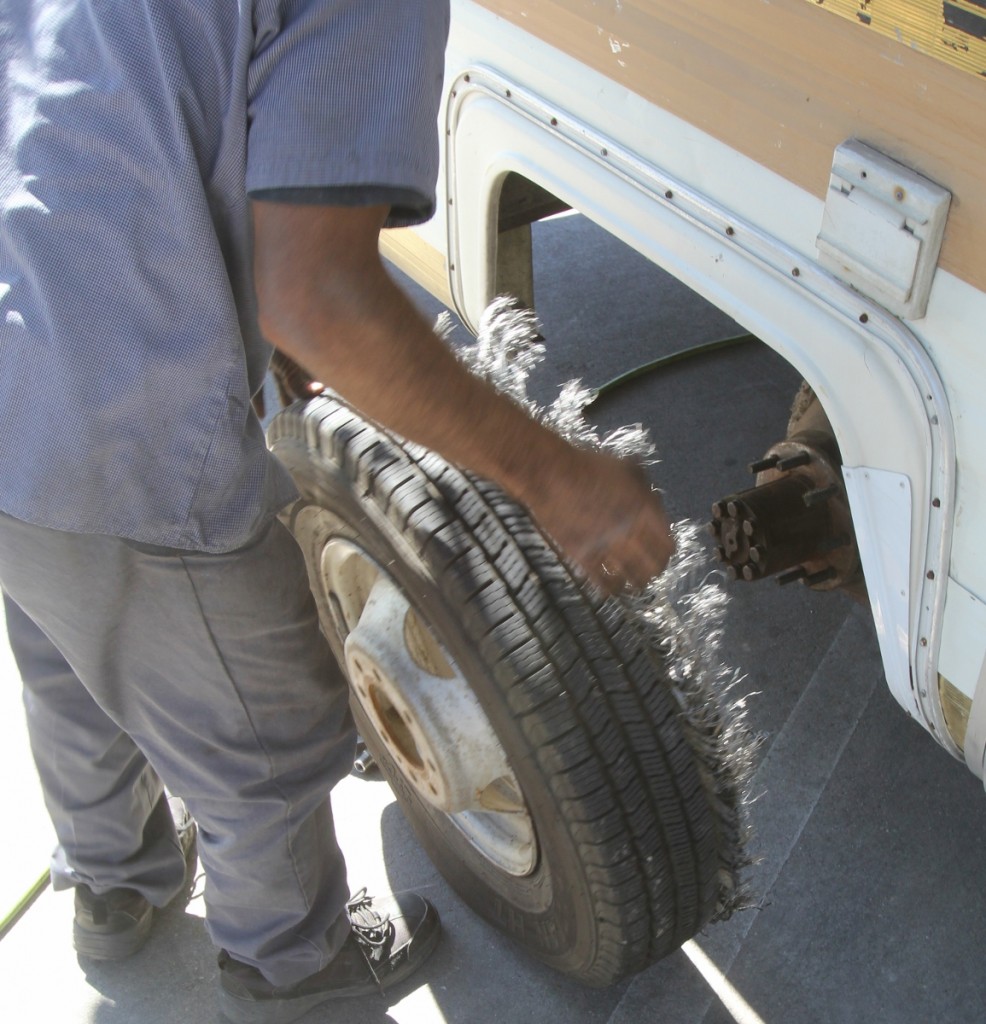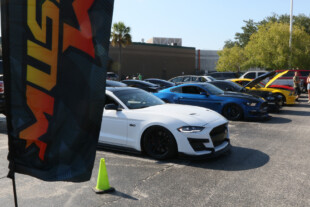A Road Trip to the Rolex Motorsports Reunion
Words And Photos: Jeff Smith
At the beginning of the classic road racing movie “Le Mans,” Steve McQueen’s character arrived at the track on a foggy morning contemplating the 200 mph speed he will achieve behind the wheel of his 917 Porsche. On an equally overcast morning in Monterey, I studied the portion of the course that I could see through the mist. That was where McQueen’s celluloid adventure and mine parted ways. I arrived in a much slower and far less grand ′76 small-block Chevy-powered motorhome. But still, here we were, treated to race engines warming up at 8 a.m. and the sweet aroma mixture of oxidized race gasoline and castor bean oil. To car guys, it’s a heady perfume.

On our trip north, the motorhome suffered a left-rear blow-out, but Tim limped it to a nearby tire store. There, we discovered the left rear inside tire was also goose-egged. The tires had less than 4,000 miles on them, but Tim says they came from North Korea! After a $440 setback for two new Firestone tires, we were back on the road.
This was my third trip to Laguna Seca for the Rolex Monterey Motorsports Reunion. My traveling companions all have far more profound racing pedigrees, and it is this experience that draws them here year after year. My friend Tim Moore is the salty 10-year Monterey veteran. The other camp dogs include Pat Pearson (SVO Club of Pat, SVOCOP.com), a long-time racer and Mustang SVO fanatic. Brad Smith is another old-hand Shelby Mustang owner who is restoring a ′69 Torino Talladega stock car, among his many other projects. The newcomer to our rabble is Chris Weleff, who owns several cars, including an ′80s platform with a Trans Am pedigree.
We started our pilgrimage with a Wednesday morning tour up California’s Highway 101, the El Camino Real, or King’s Highway that winds its way along the Pacific coast from San Diego up through the Monterey peninsula — the land of John Steinbeck and “Cannery Row.” Far removed from that depression-era novel is the ostentatiousness the Reunion attracts. Almost immediately upon our arrival, Brad observed, “Only here when you drive a Ferrari, you realize it’s a just another belly button car.” Indeed, it seems that every five minutes from our camp near the track’s southern entrance, a new prancing horse, Lamborghini, or other angular exotic would cruise past. Their arrival was usually accompanied by the high-pitched scream of a 180-degree exhaust that might best be described as Carl Benz meets a Star Wars X-wing fighter.
Thursday morning, we made our first pass through the pits after purchasing our $160 race passes. Painful as it was, it’s worth it just to cruise the pit lanes burgeoning with cars you might recall from grainy black-and-white magazine photos.
My appreciation for turning corners began in 1980 when I had the opportunity to slide behind the wheel of a Van Diemen Formula Ford in the Jim Russell British School of Motor Racing class at Riverside. Powered by a Cortina four-cylinder, it might sound slow, but with your butt an inch from the pavement, this car quickly demanded I learn rudiments of performance driving. Our instructor called the track surface “ashfault.” It was wonderful and the lessons quickly embedded.
This was an especially good year to attend Monterey as it was the 50th anniversary not only of the start of the SCCA Can Am series, but also of Trans Am. The Rolex Reunion attracted a lumbering field numbering nearly 100 between the two classes. And I can’t think of a more superb place to hold such a reunion. Mazda Raceway Laguna Seca’s inaugural race was in 1957. It sits on land deeded to Monterey County from the neighboring Ford Ord Army base. Our campsite is mere yards from a small knoll overlooking Turn 5 that leads straight uphill.
Laguna Seca is perhaps most famous for its extreme elevation change at what is known as the Corkscrew. In a race car, the bottom of the car seems to drop out from under you with a 109-foot near freefall just between the top of the Corkscrew at Turn 8 and Turn 9. That’s more than 10 stories. This also makes for an excellent place to watch the cars spill down the hill. Once you make the trek to the top, you can alternate between watching the action at the Corkscrew or slip over the ridge to view nearly every other corner from the west side of the hill. It’s an amazing experience.
But it was the cars we really came to see. The pits were crammed with race cars that date back to the turn of the century. While the oldest machines are intriguing in their antiquity, it is the ultimate V8 supercars — the Can Am and Trans Am machines we inevitably must seek out. David Pozzi had the foresight in 1974 to purchase a wrecked Lola T70 Can Am car for a mere $600. The car needed quite a bit of work, as the left rear had been completely torn from the chassis. But over the subsequent 40 years, David never gave up on its rejuvenation. After retiring from farming and finishing the car in a stunning blue livery two years ago, the Lola debuted at this event.
The car now sports a 355c.i. small-block Chevy and multiple Weber carbs, even though Pozzi’s vintage photos reveal the car also ran with a single carburetor. “I’m really happy with the car,” David said. “It might need some bigger carburetors because it runs out of air at the higher rpm. But it’s fun!” Because original owner Buck Fulp competed in the United Stated Road Racing Championship (USRRC), Pozzi was classified with the USRRC cars in Group 5A at the Reunion and finished well on Saturday. All from a $600 shell.
Returning to the pits on Friday, I connected with my first editor/boss/friend Rick Voegelin, who introduced me to Herb Adams and his ′64 GTO wheeled by Bob Tullius in the 1971 Trans Am race at Lime Rock, Connecticut. While the Adams effort DNF’d because of a blown head gasket at its inaugural race, Tullius proved the car’s potential by driving from dead last on the starting grid to second only behind the Penske-Donohue Javelin before the steam genie appeared. Recently, John Hildebrand purchased the car and in a manic 90-day restoration, brought the Pontiac to Monterey. Saturday’s race saw the GTO finish fifth against a stellar field of Trans Am cars. Herb had told me they were shooting for a Top 10 place, so this was a fantastic debut for a car that started out as Herb’s wife’s grocery getter.
Of course, there were also dozens of other things to do besides watch racing and dream of sitting on the starting grid in your own vintage race cars. In Monterey, there were something like seven different classic car auctions, separate car shows virtually every day, and plenty of restaurants to keep you busy. RM Sotheby’s auction set a record when they sold Carroll Shelby’s original Cobra that included its original ratty interior patina for an astonishing $13.75 million. The previous record was $11 million for a GT40. We decided the $20 entry fee was more than we wanted to spend for the thrill of watching somebody drop nitrogen-cooled checking account dollars on a car. It’s a whole different world.
Saturday was a compression of racing sights and sounds. Our camp site talks that night (and every night) always revolved around team effort plans to build a car that would allow us to jump the wall between enthusiastic spectator and financially-reckless participant. We don’t aspire to compete with Bruce Canepa and his multi-car team transports and catered lobster bisque. The dream is closer to an open trailer and PBJ sandwiches. Racing and Monterey are about hanging it out there on that ragged edge of undulating asphalt. It does this to me every year.

















